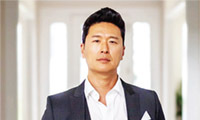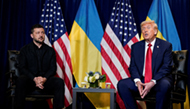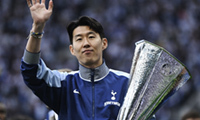BEIJING - If Westerners feel dazed and confused upon exiting the plane at the new international airport terminal here, it’s understandable. It’s not just the grandeur of the space. It’s the inescapable feeling that you’re passing through a portal to another world, one whose fierce embrace of change has left Western nations in the dust.
Designed by Norman Foster, Beijing’s glittering air terminal is joined by a remarkable list of other new monuments here: Paul Andreu’s egg-shaped National Theater; Herzog & de Meuron’s National Stadium, known as the bird’s nest; and Rem Koolhaas’s headquarters for the CCTV television authority, whose slanting, interconnected forms are among the most imaginative architectural feats in recent memory.
Critics have incessantly described these high-profile projects as bullish expressions of the nation’s budding global primacy. Yet these buildings are not simply blunt expressions of power. Like the great monuments of 16th-century Rome or 19th-century Paris, China’s new architecture exudes an aura that has as much to do with intellectual ferment as economic clout.
Each building, in its own way, embodies an intense struggle over the meaning of public space in the new China. And although at times terrifying in their aggressive scale, they also reflect the effort to shape the nation’s identity.
Yet your sense of marvel at China’s transformation is easily deflated on the drive from the airport. A banal landscape of ugly new towers flanks both sides. Many of those towers are sealed off in gated compounds, a reflection of the widening disparity between affluent and poor. China’s architectural experiment brims with both promise and misery. Everything, it seems, is possible here .
These tensions and contradictions are encoded in Mr. Andreu’s National Theater, just west of Tiananmen Square. The theater complex stands along the Avenue of Eternal Peace, the great east-west corridor that borders Tiananmen Gate. Mr. Andreu described it as a place “open to ordinary citizens.
Yet the building’s symmetrical layout and monolithic scale invite other interpretations. The isolation imposed by the surrounding reflecting pool is reinforced by the entry sequence: visitors must descend a grand staircase into the earth before passing under the pool and reemerging in the cavernous dome. It’s as if the theater were connected to the city by a gigantic umbilical cord.
Yan Meng, a Chinese architect who grew up in Beijing in the aftermath of the Cultural Revolution, suggests that the National Theater’s circuitous entry echoes the clampdown on public life after the 1989 massacre in Tiananmen Square. “It no longer belongs to anyone, he said of the square. “It is about control.
But some of the most imposing architectural symbols of China’s rising stature reflect a more enlightened reading of how the future might unfold. The Olympic Stadium, designed by Jacques Herzog and Pierre de Meuron, and the National Aquatics Center lie 16 kilometers north of the city center . The stadium’s elliptical form is enveloped in a dense latticework of steel columns. Their outward thrust suggests they are straining to contain the activity inside.
Yet a conflict over the stadium’s future underscores tensions over how the new China will be defined. The stadium is in the center of a sprawling park surrounded by regimented rows of housing towers. After the Games, Mr. Herzog and Mr. de Meuron hope to transform the building into a vast public forum and a visual anchor for the community. The government prefers to build a fence around it . “The building is made to be open, Mr. Herzog said. “It is a work of public sculpture.
Mr. Koolhaas faces similar strains in his headquarters for CCTV, the state television authority .
It remains to be seen where all this will lead. For centuries, architects have aspired to create buildings that enlighten or transform civilization, only to see them remain isolated splendors, with little impact on society at large. That may prove to be the case in China, too.
But there is no question that its role as a great laboratory for architectural ideas will endure for years to come. One wonders if the West will ever catch up.
솟아오르는 새로운 중국의 비전
베이징에서 니콜라이 오우로우소프
베이징의 새 국제공항 터미널에서 비행기를 내리며 서구인들이 어리둥절해 하는 것은 이해할만 일이다. 공간의 위용만이 아니다. 맹렬히 변화를 수용하여 서구 제국들을 앞지르고 있는, 또 다른 세계로 통하는 관문을 지나고 있다는 느낌을 피할 수 없기 때문이다.
노먼 포스터가 디자인한 화려한 공항 터미널 이외에도 베이징에는 눈에 띄는 새로운 기념물들을 열거할 수 있다. 폴 앤드루의 달걀 모양 국립극장, 새둥지라고 알려진 헤어조그 & 드 뮈롱의 국립경기장도 있다. 렘 콜하스의 CCTV 텔리비전 공사 본부의 비스듬히 서로 연결된 형태들은 최근에 지어진 가장 상상력 풍부한 건축적 위업중 하나다.
평자들은 이처럼 명확히 눈에 들어오는 건축 프로젝트들은 이제 눈트기 시작한 이 나라의 세계적 우위에 대한 우직한 표현이라고 설명했지만 이 건물들은 그저 솔직한 힘의 표현만은 아니다.
16세기 로마나 19세기 파리의 위대한 기념물들처럼 중국의 새 건축물들이 뿜어내는 매력에는 경제적 영향력만큼이나 지적인 분출과도 연관이 있다.
각각의 건물에는 나름대로 이 새로운 중국에서 공공 장소가 갖는 의미에 대한 치열한 탐구가 구현되어 있다. 때로 그 엄청난 규모에 질리기도 하지만 나라의 정체성을 갖추기 위한 노력도 반영되어 있다.
그러나 공항에서부터 자동차를 타고 들어오다보면 중국의 변형에 대한 경이로운 기분이 쉽게 사라진다. 길 양쪽은 새로 지은 보기 흉한 고층빌딩들로 진부한 풍경을 이루고 있다. 그 고층빌딩들은 대부분 출입문 달린 주거단지 안에 밀폐돼 있어 점점 심화되는 빈부격차를 드러내고 있다. 중국의 건축적 실험은 장래성과 비참함 모두로 넘친다. 이곳에서는 무엇이든 가능해 보인다.
그 긴장과 모순은 텐안먼 광장의 바로 서쪽에 자리잡은 앤드루의 국립극장에 잘 드러나 있다. 극장 단지가 텐안먼에 면한 큰 동서방향 통로인 영원한 평화의 거리를 따라 세워져 있는데 앤드루는 그것을 “일반 시민에게 열려있는 “곳이라고 설명한다.
그러나 그 건물의 대칭적 구조와 거대한 규모는 다른 해석도 가능케한다. 건물 둘레를 에워싼 연못으로 인한 고립감은 입장 순서로 인해 증폭된다. 관람객은 으리으리한 계단으로 내려와서 연못 아래로 지나가야 동굴같은 반구형 건물으로 다시 들어선다. 마치극장이 커다란 탯줄에 의해 도시와 연결된 것 같다.
문화혁명 이후에 베이징에서 자란 중국 건축가 얀 멩은 국립극장의 에두르는 입장은 1989년 텐안먼 광장에서 발생한 시위대 학살 이후 공공 생활의 탄압을 반향한다고 말한다. “그 광장은 이제 아무에게도 속해있지 않습니다. 그것은 통제를 말하지요”
그러나 중국의 격상되는 지위를 상징하는 가장 위풍당당한 건축물 중에는 미래가 어떻게 펼쳐질 것인지에 대해 훤히 통달한 것 같아 보이는 것도 있다. 자크 헤어조그와 피에르 드 뮈롱이 디자인한 올림픽 경기장과 국립수상경기센터는 시 중심가에서 16킬로미터 북쪽에 자리잡고 있다. 경기장은 촘촘하게 격자세공된 철강 기둥들로 둘러 싸인 타원형인데 그 외벽의 돌출은 마치 경기장내 활동을 품느라고 긴장하고 있는 것 같다.
그러나 이 경기장의 장래를 둘러싼 갈등에서도 새로운 중국이 어떻게 규정될지를 둘러싼 긴장을 엿볼 수 있다. 경기장은 질서 정연히 줄지어 있는 주거용 고층건물들로 둘러싸인 공원 한가운데 자리잡고 있다. 헤어조그와 드 뮈롱은 올림픽 경기가 끝난 다음에 이 건물이 넓은 공공의 광장이자 공동체의 눈에 보이는 닻이 되기를 희망한다. 정부는 그 주변에 담장을 치는 편을 선호한다. “이 건물은 공개되려고 만들어진 겁니다. 공공 조각작품이예요”라고 헤어조그는 말했다.
콜하스도 국영텔리비전공사 CCTV 본부 건물 때문에 비슷한 일을 겪고 있다.
이 모든 일이 어떻게 전개될지는 두고 볼 일이다. 수백년에 걸쳐 건축가들은 문명을 교화시키거나 변형시킬 건물을 창조하겠다는 뜻을 품어왔지만 사회에 널리 미치는 영향은 별로 없이 고립된 채 남아 있는 것을 보아왔다. 중국에서도 그렇게 될지 모른다.
그러나 중국이 앞으로도 계소 건축적 이상의 위대한 실험실 노릇을 할 것에는 의심의 여지가 없다. 서구가 과연 따라잡을 수 있을지가 궁금할 뿐이다.
어휘 해설
in the dust 죽어서, 굴욕을 당하여
has much to do with 관련된
in its own way 그 나름대로, 형편대로
high-profile 고자세;명확한 태도[정책], 선명한 입장;주의를 끌려고 하는 태도
at times 때때로, 이따금
tower 고층빌딩
Tiananmen Square중국 베이징의 톈안먼 광장
encode <보통 문장을> 암호로 바꿔 쓰다;부호화하다
circuitous <말 따위가> 에두르는, 간접적인, 넌지시 말하는
clampdown 단속, 탄압
latticework 격자 세공;[집합적] 격자
스마터리빙
more [ 건강]
[ 건강]이제 혈관 건강도 챙기자!
[현대해운]우리 눈에 보이지 않기 때문에 혈관 건강을 챙기는 것은 결코 쉽지 않은데요. 여러분은 혈관 건강을 유지하기 위해 어떤 노력을 하시나요?
 [ 건강]
[ 건강]내 몸이 건강해지는 과일궁합
 [ 라이프]
[ 라이프]벌레야 물럿거라! 천연 해충제 만들기
 [ 건강]
[ 건강]혈압 낮추는데 좋은 식품
[현대해운]혈관 건강은 주로 노화가 진행되면서 지켜야 할 문제라고 인식되어 왔습니다. 최근 생활 패턴과 식생활의 변화로 혈관의 노화 진행이 빨라지고
사람·사람들
more많이 본 기사
- 특검, 尹에 징역 10년 구형… “법치주의·사법질서 파괴”
- 韓정부, 노란봉투법 해석 지침 공개… 하청 임금·근로조건 좌우하면 ‘진짜 사장’
- 트럼프 “소말릴란드 아는 사람 있나?”…이스라엘 승인에 ‘NO’
- 한파에 고드름이 주렁주렁… 서울 이번 겨울 첫 한파주의보
- ‘서해 공무원 피격 은폐’ 혐의 서훈… 1
- ‘정보 유출자 셀프 조사’ 경찰에 늦게 알린 쿠팡… 증거인멸 의혹
- “아동 수출국 오명 벗는다” 70년 만에 해외입양 중단
- 황하나, 마약 도피 중 캄보디아서 출… 1
- “올해 최고 주목받은 테크 거물은 머스크 아닌 래리 엘리슨”
- 찰스 3세, 내년 방미 추진…트럼프에 英왕실 ‘매력 공세’될까
- ‘김건희에 로저비비에 선물’ 김기현 부인 특검 재출석…곧 기소
- 소싯적 ‘치기어린’ 주소 “굿바이”…지메일 주소변경기능 도입
- “출생시민권은 사기”⋯ 이민 2세대 공격 초점 맞춘 트럼프
- 특검, 김건희 ‘금품 수수’ 무더기 기소… 뇌물 여부는 경찰 몫으로
- 이혁재가 또.. “빌려간 3억원 안 갚아” 사기 혐의로 피소
- 트럼프 압박에 굴복 UVA 총장 선출 강행
- “영원한 생명 주실 승리의 하느님 오신 날”
- 쏟아지는 갑질·특혜 의혹… 버티는 김병기, 속 끓는 정청래
- 러, 트럼프-젤렌스키 종전회담 직전 키이우 대규모 공습
- VA·MD 7명 생굴 먹고 식중독…22개주 60여명 감염
- ‘NCT 탈퇴’ 태일, 성폭행 혐의로 결국 감옥行..징역 3년 6개월 확정
- 작년 운용자산 5조5천억달러…갑부들의 ‘패밀리오피스’ 월가 새 강자로
- “연말은 스트레스·새해 결심은 없다”
- 與 ‘통일교·신천지 특검법’ 발의… 野 “뜬금없다”
- ICE 버지니아 구금시설 ‘포화’…수감자 역대최고
- 미국, 美방산기업 제재한 中에 “대만 무기판매 보복 강력반대”
- 물류거점창고에 불체자 8만명 수용 추진
- LA 등 서부에 사흘째 폭우…동부엔 폭설 예보
- 린다 한 “내년 1월17일 별도 한인회연합회 만들겠다”
- 뉴욕한인회, 이번에 이사장 자리 놓고 내홍 조짐
- ‘역대 최연소’ 백악관 대변인 레빗,… 1
- 곽도원, 음주운전 3년 만 복귀각..스토리제이컴퍼니 측 “미팅 했지만 계약 단계 아냐”
- 맘다니 취임위원회에 ‘파친코’ 이민진 작가 위촉
- 대만이슈 돌출로 美中 ‘삐걱’…내년 4월 트럼프 방중前 기싸움?
- [이지 사이언스] “온난화 막으려면 세계인구 44% 식단 바꿔야…문제는 소고기”
- 조지아 역주행 사고, 한인남편 이어 임신 아내도 사망
- 국제은값 폭등에 개인투자자들 銀투자 대거 유입
- ‘학자금 상환’ 안하면 임금압류
- “엔비디아, AI칩 스타트업 인수 아닌 기술 계약으로 규제 회피”
- ‘손흥민 감격의 첫 우승’ 올해 축구계 기적 톱8 선정 ‘선수로는 유일’
- 젤렌스키 “28일 트럼프와 종전안 논의…영토·원전 외 90% 완성”
- “새해 1호 법안은 2차특검” 정청래, 강경 기조 그대로
- 16세로 성장한 버클리 문학, 성대한 송년 파티
- 김정은, 핵잠 이어 미사일 공장도 시찰
- 8시즌 뛰고 ML 역대 17위 “오타니 GOAT 될 것”, ML 역대 50인 선정
- ‘마약 혐의’ 남양유업 3세 황하나 구속… “증거인멸 우려”
- “온 세상에 희망·평화의 빛 스며들길”
- 기이한 재력 과시 ‘가난 밈’ 확산에..신화 김동완 “이게 농담이라고?” 뿔났다
- 마이큐♥김나영, 제주로 떠났다..행복한 네 가족
- 곽튜브, 재산 100억설에 입 열었다.. “얼마 안 남은 듯”
1/5지식톡

-
 미 육군 사관학교 West Poin…
0
미 육군 사관학교 West Poin…
0https://youtu.be/SxD8cEhNV6Q연락처:wpkapca@gmail.comJohn Choi: 714-716-6414West Point 합격증을 받으셨나요?미 육군사관학교 West Point 학부모 모…
-
 ☝️해외에서도 가능한 한국어 선생님…
0
☝️해외에서도 가능한 한국어 선생님…
0이 영상 하나면 충분합니다!♥️상담신청문의♥️☝️ 문의 폭주로 '선착순 상담'만 진행합니다.☎️ : 02-6213-9094✨카카오톡ID : @GOODEDU77 (@골뱅이 꼭 붙여주셔야합니다…
-
 테슬라 자동차 시트커버 장착
0
테슬라 자동차 시트커버 장착
0테슬라 시트커버, 사놓고 아직 못 씌우셨죠?장착이 생각보다 쉽지 않습니다.20년 경력 전문가에게 맡기세요 — 깔끔하고 딱 맞게 장착해드립니다!장착비용:앞좌석: $40뒷좌석: $60앞·뒷좌석 …
-
 식당용 부탄가스
0
식당용 부탄가스
0식당용 부탄가스 홀세일 합니다 로스앤젤레스 다운타운 픽업 가능 안녕 하세요?강아지 & 고양이 모든 애완동물 / 반려동물 식품 & 모든 애완동물/반려동물 관련 제품들 전문적으로 홀세일/취급하는 회사 입니다 100% …
-
 ACSL 국제 컴퓨터 과학 대회, …
0
ACSL 국제 컴퓨터 과학 대회, …
0웹사이트 : www.eduspot.co.kr 카카오톡 상담하기 : https://pf.kakao.com/_BEQWxb블로그 : https://blog.naver.com/eduspotmain안녕하세요, 에듀스팟입니다…
케이타운 1번가
오피니언

새해 더 중요해지는 노동법 준수

연말연시, 안전하고 차분하게
 캐슬린 파커 워싱턴포스트 칼럼니스트
캐슬린 파커 워싱턴포스트 칼럼니스트 [캐슬린 파커 칼럼] 지미 라이의 마지막 희망
 유경재 나성북부교회 담임목사
유경재 나성북부교회 담임목사 [한국춘추] 미국의 힘
 전병두 서북미수필가협회 회원
전병두 서북미수필가협회 회원 [금요단상] 비자 발급
 박일근 / 한국일보 수석논설위원
박일근 / 한국일보 수석논설위원 [지평선] 스님의 주례사
 신상철 / 고려대 고고미술사학과 교수
신상철 / 고려대 고고미술사학과 교수 [미술 다시보기] 신의 모습을 닮고자 한 예술가
 스티브 강 전 한인민주당협회 회장
스티브 강 전 한인민주당협회 회장 [스티브 강 ‘인사이드 미국’] 2026 중간선거: 트럼프 지지율 하락이 말해주는 것
 김홍일 케이유니콘인베스트먼트 대표
김홍일 케이유니콘인베스트먼트 대표 [기고] 안정의 기준은 어떻게 제도가 되었나
1/3지사별 뉴스

물류거점창고에 불체자 8만명 수용 추진
도널드 트럼프 행정부가 이민자 구금·추방을 효율화하기 위해 전국 물류거점 창고에 8만명 규모의 수용시설 확보를 추진한다고 24일 워싱턴 포스트…
‘학자금 상환’ 안하면 임금압류

“온 세상에 희망·평화의 빛 스며들길”
가자지구와 우크라이나에서의 전쟁, 고립과 불평등으로 세상이 어지러운 가운데 워싱턴 지역 각급 한인교회와 성당들이 성탄절을 맞아 일제히 예배와 …
“연말은 스트레스·새해 결심은 없다”

‘손흥민 vs 메시’ 2026 MLS 개막전서 세기의 맞대결 예고
LA 풋볼클럽(LAFC)가 2026시즌 MLS 정규리그 일정을 공식 발표하며 한인 축구 팬들의 시선을 한몸에 받고 있다. LAFC는 오는 20…
[새해부터 이렇게 달라진다] 최저임금 또 오르고… 유급 병가는 더 확대

오늘 하루 이 창 열지 않음 닫기 





















































.png)


댓글 안에 당신의 성숙함도 담아 주세요.
'오늘의 한마디'는 기사에 대하여 자신의 생각을 말하고 남의 생각을 들으며 서로 다양한 의견을 나누는 공간입니다. 그러나 간혹 불건전한 내용을 올리시는 분들이 계셔서 건전한 인터넷문화 정착을 위해 아래와 같은 운영원칙을 적용합니다.
자체 모니터링을 통해 아래에 해당하는 내용이 포함된 댓글이 발견되면 예고없이 삭제 조치를 하겠습니다.
불건전한 댓글을 올리거나, 이름에 비속어 및 상대방의 불쾌감을 주는 단어를 사용, 유명인 또는 특정 일반인을 사칭하는 경우 이용에 대한 차단 제재를 받을 수 있습니다. 차단될 경우, 일주일간 댓글을 달수 없게 됩니다.
명예훼손, 개인정보 유출, 욕설 등 법률에 위반되는 댓글은 관계 법령에 의거 민형사상 처벌을 받을 수 있으니 이용에 주의를 부탁드립니다.
Close
x